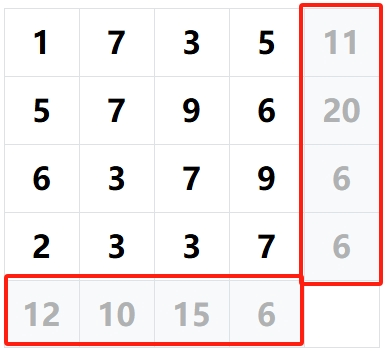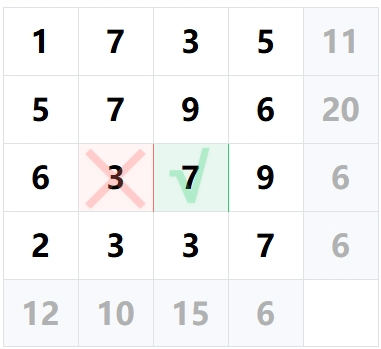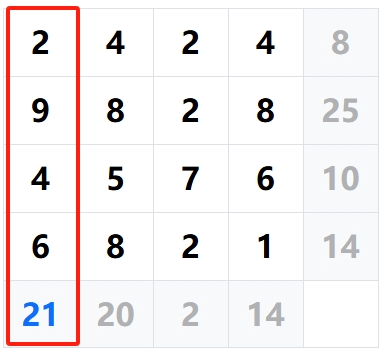Sumplete
What is Sumplete?
Sumplete is a number puzzle game that combines addition calculations with logical reasoning. The goal of the game is to delete the appropriate numbers so that the sum of the remaining numbers in each row and column equals the target value. Although it may seem like a "simple addition puzzle," the complexity increases as the grid size grows and the number combinations become more diverse, making it a fun challenge that requires focused logic.
Game Origins
Sumplete was originally proposed by the AI community as a way to test the differences in mathematical logic reasoning between humans and AI. With simple rules and multiple solutions, it quickly gained popularity among puzzle enthusiasts worldwide, becoming a popular new game for training numerical logic.
Game Rules
1. Grid Size Selection
Before starting the game, you need to choose the grid size, with options ranging from 3×3 to 9×9. Smaller grids are suitable for beginners, while larger ones challenge your reasoning abilities and calculation speed.
2. Difficulty Selection
The game offers three difficulty levels:
- Easy: Target sums are evenly distributed, with smaller numbers, suitable for beginners.
- Medium: The target sums are a bit more complex, and the numbers are larger, requiring more reasoning.
- Hard: Target sums are more complicated, with a mix of positive and negative numbers, demanding flexible reasoning and multiple attempts.
3. Target Sum

At the right and bottom of each row and column, you will see a target sum. This indicates the total sum the numbers in that row or column should equal. Your task is to delete or keep numbers so that the remaining numbers in each row and column exactly match their respective target sums.
4. Number Operations

- Delete: Click a number once, and it will be marked for deletion. Deleted numbers are excluded from the sum calculations for that row or column.
- Keep: Click a number twice, and it will be marked as "kept." Kept numbers are included in the sum calculations for that row or column.
- Restore: Click a number three times to return it to its default state (neither deleted nor kept), and it will again be included in the sum calculation for that row or column.
With each click, the game will automatically check whether the sum of the active numbers in the row and column matches the target value. If they match, the target value will be highlighted.
5. Completing the Game

The game is completed when the sum of the remaining numbers in each row and column exactly matches the target sum. Once all the target sums are satisfied, the game ends, and you can view the time it took to complete the challenge and try to break your record.
6. Feature Buttons
- Hint: Click the hint button, and the system will suggest a valid number marking strategy to help you find the next correct step.
- Answer: Click the answer button to display the full solution, showing you how to complete the puzzle. Want to solve your own custom grid? Try our Sumplete Solver to quickly find a working solution or verify if your setup is solvable.
- Reset: Click the reset button to restore the game to its initial state and start over.
- Timer: The game automatically tracks the time it takes to complete the puzzle. Each time you play, you can try to improve your speed.
How to Solve Sumplete Efficiently
Although Sumplete is a number reasoning game designed by AI for humans, mastering a few techniques can significantly improve your puzzle-solving efficiency:
1. Find Rows or Columns with No Changes Needed

If the sum of all the numbers in a row or column exactly equals the target value (which will be highlighted after the grid loads), then all the numbers in that row or column must be kept! This will lock in many cells and reduce the complexity of reasoning.
2. Focus on Rows or Columns with Small Target Sums

If the target sum is small, many of the larger numbers in that row or column can't possibly be kept, so delete them first. For example, if a column's target sum is 4, and one cell has a 7, that cell should almost certainly be deleted.
3. Prioritize Rows or Columns with Extreme Number Distributions
For example, if a row contains 1, 1, and 8, and the target sum is 2, it's clear you should keep the two 1s and delete the 8. The larger the number difference, the easier it is to reason.
4. Use Cross-Validation
Once you've locked in the numbers to keep in a row, they will also appear in the columns. Continue checking whether the target sums for those columns are reasonable, narrowing down possibilities.
5. Take Advantage of the "Marking" System
Click once to delete, click twice to keep. This clear marking system not only helps you spot conflicts but also serves as a note-taking method for layout decisions.
6. Start with Small Grids to Build Number Sense
For beginners, it's recommended to start with 3×3 or 4×4 grids. Once you get the hang of "reverse calculation," you can gradually challenge yourself with larger grids, such as 7×7 and beyond.
Frequently Asked Questions
-
How is Sumplete different from Sudoku?
Sudoku focuses on number arrangement, while Sumplete is more about addition logic and number combination reasoning, offering greater flexibility in gameplay.
-
What if I make a wrong move?
You can click again to reset the number to its default state (click once to delete, twice to keep, three times to restore), or use the reset button to start over.
-
How can I check if the target sum matches the row or column total?
Each time you click, the system will automatically check and highlight the target sum if it matches, or display it in gray if it doesn't.
-
Is there a general solution strategy?
There's no single solution, but starting by finding extreme values, locking in unique numbers, and then using cross-validation is the most effective strategy.
-
Do I need to delete all numbers in a row or column?
No. Since the target sum is not 0, at least one number must be kept in each row or column.
-
What's the difference between difficulty levels?
The difficulty level determines the puzzle's complexity. In Easy mode, the numbers are smaller and simpler, suitable for beginners. In Medium and Hard modes, the puzzles become more uncertain and require more detailed reasoning. Hard mode, especially, mixes in negative numbers, so it's essential to understand how addition works with negatives.
-
Who is this game suitable for?
It's perfect for anyone who enjoys number puzzles, addition logic, and mental challenges. Whether you're a math enthusiast or a puzzle lover, you'll find both fun and brain training in this game.